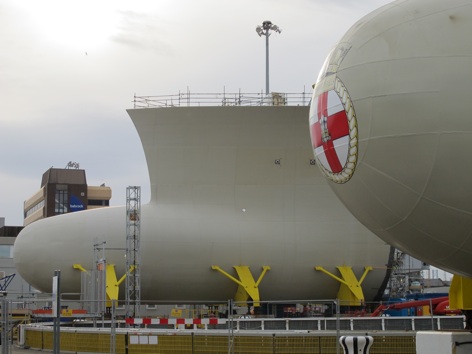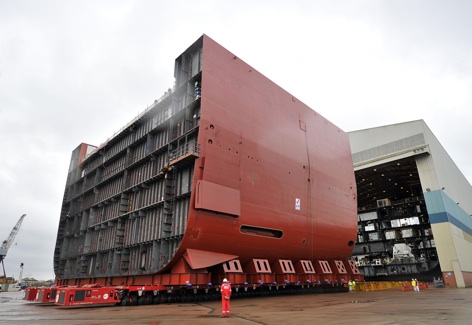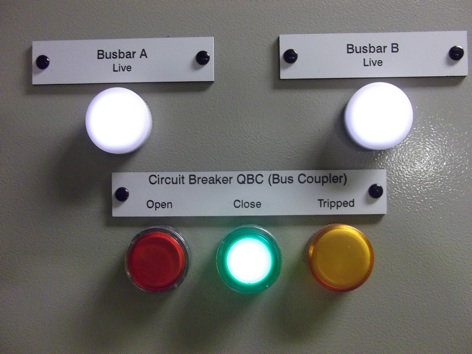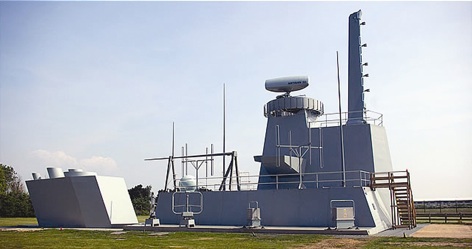The second of the Queen Elizabeth Class Carriers Prince of Wales is starting to make its presence felt at Rosyth with the arrival of the lower parts of the bow, including the bulbous bow, from the Appledore Shipyard where it was built. The two bow sections — one for Queen Elizabeth and one for Prince of Wales — now stand at either side of the head of the dry dock, such that from the ACA offices they effectively provide a frame for the bulk of Queen Elizabeth’s Superblock 03 in the dry dock. Transportation of this bow section was the 15th successful sea transit under taken on the QEC project and went very well, however we are all very much aware that each of these evolutions requires the same degree of care and attention to ensure that they are carried out safely and successfully and each movement is followed up by a lessons learnt session to capture the best practice.

On Easter Monday at the Govan shipyard rings M and N of QE’s Lower Block 04 were moved from one of the bays of the build hall and aligned with the remaining rings of LB04 in another bay of the build hall. This evolution involved the movement of a structure weighing over 4000 tonnes a distance of about 100 metres using a large number of interconnected hydraulic axles. The whole operation took about an hour to complete, which was well within the allocated timescale. The combined Lower Block 04 is now almost 90 metres long, 40 m wide and weighs in excess of 11,000 tonnes. Work will now progress on completing the block and preparing it for transport to Rosyth in the autumn.

While progress with steelwork is very obvious and visible, what is less visible but particularly pleasing is the extent to which this steelwork is being outfitted with the thousands of parts, miles of pipe, cable and ventilation trunking that make up the completed ship. A recent visit to the build yards by an American shipbuilder, familiar with the building of large warships for the US Navy, left them with a very favourable impression of the amount of work that had been completed.
The shipyards are pressing on with the construction of the constituent parts and the assembly of these into blocks and then superblocks, but that is only part of the story. The Commissioning Engineers who will set to work and test all the ship’s systems are busy preparing for their activities which will bring the ships alive, and the Aircraft Carrier Alliance (ACA) is under no illusion of the challenges that the commissioning process will pose, not least because of the sheer size of these ships. A very robust commissioning plan has been developed and is being subjected to rigorous review and scrutiny to ensure that all the interfaces and dependencies have been taken into account. It is particularly important that configuration control is maintained throughout the commissioning phase so that the extent to which systems have been completed is clearly known and that all the necessary safeguards are in place. The ACA is using a Completions Management Software system to help manage this important process and it is believed that this project may be the first application of such software to a shipbuilding project; similar tools have previously been used in the oil and gas and civil engineering industries.
The commissioning process have been proved through the setting to work of the 440V switchboards within Lower Block 02 which have now gone live and paves the way to the distribution of Low Voltage electrical supplies throughout the block so that the ship’s lighting system can be energised and temporary lighting will be no longer required. This is a significant achievement for the team, was completed ahead of schedule and was the result of a good joint working arrangement between a number of individuals from across the Alliance.

I have recently undertaken a tour of the Integration facilities, predominantly around the south coast of England, where the integration of the electronic systems that make up the ship’s Mission Systems including Air Traffic Control, Navigation, Communications and associated radars and sensors is beginning. The facilities are extremely impressive and include at Cowes on the Isle of Wight a full scale mock-up of the aircraft carrier’s aft island structure including the pole mast and the Medium Range Radar. This facility has been used to test out the arrangement of the sensors to ensure that mutual interference issues can be resolved and is now being used to integrate the sensors with other parts of the Mission Systems. The main shore integration site is on top of Portsdown Hill overlooking Portsmouth where it can use some of the radars and sensors deployed on the Type 45 Destroyers and other Royal Navy ships. It is possible to connect the radars at Cowes with the facility at Portsdown to give real time integration of the radar pictures. A further integration site is being commissioned at the Royal Navy Warfare School, HMS Collingwood, at Fareham. This facility will include a near full scale representation of the ship’s operations room and its location will ensure a plentiful supply of Royal Navy trainees who will be able to give the systems a very thorough test before installation into the ships. All this work is extremely important to de-risk the integration onboard the ship and ensure that the time between completing the build and taking the aircraft carriers into service is as short as practical.

It is now 30 years since the Falklands Conflict and it is important to remember the part that the aircraft carriers HMS Hermes and HMS Invincible and their Harrier aircraft played in the successful outcome of that conflict, and while looking at the flags flying outside the office with the part complete HMS Queen Elizabeth beyond, the importance of what we are doing becomes very clear.











BEAS funding available to help businesses cut energy costs
And not a moment too soon, if the following exchange broadcast last Friday 13th June, on the Radio 4 ´Rare Earth´ program (link below, ~ 17 minutes...